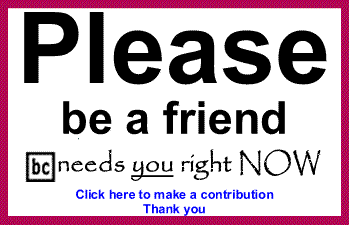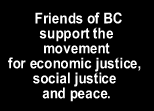
|
||||||||||||||||||||||
 |
||||||||||||||||||||||
 |
||||||||||||||||||||||
 |
||||||||||||||||||||||
 |
||||||||||||||||||||||
 |
||||||||||||||||||||||
 |
| The current issue is always free to everyone |
|
|
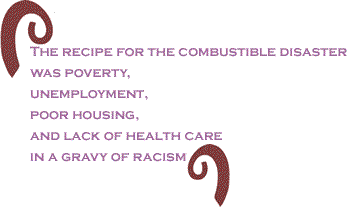 |
| The recent acquittal of NYPD undercover detectives,
Michael Oliver, Gescard Isnora and Marc Cooper, can be likened
to throwing a Molotov cocktail in a room full of powder kegs
- and missing this time. The incendiary cocktails are
the legal justifications by the
Those conditions are again reaching their tipping
point. But we’ve also seen that the most common inflammatory
ingredient on a smaller scale has been an act of police terrorism.
Subsequently, cities like
Most police departments have been shielded by the law, regardless of their acts of violence and misconduct. Time after time, there is no justice for the individual citizen or the community. Even the most valiant efforts of committed groups fighting against these atrocities have been muted. I have been in such formations for nearly 35 years and occasionally got an officer fired or got compensation for victims and their families through civil suits. But never have we been successful at getting criminal charges to stick, thereby sending a message that black life does count. Under this scenario, the rogue cops become more emboldened and impatient victims become more desperate. About five years ago, I began seeing and hearing from young, black men that, with the kind of lawlessness by police seemingly condoned by the justice system and the community, they had no choice but to take matters into their own hands. These young, men - not all drug dealers and robbers - expressed the need to defend themselves against the police. Translation: Take them out before they take me out. Now, young men are not just trying to outrun the cops, they are shooting back. Nationwide, estimates of the number of law enforcement officers killed in the line of duty show an increase of 30 percent in 2007 compared with 2006. And the numbers are growing. Police can now claim to have material justification for the hypersensitivity to danger in the hood. The “I felt threatened” rationale is used in many situations. Police departments and police associations have their strategy down. They often get unconditional support from elected officials, i.e. increased budgets, better fire-power, etc.
As our young people struggle to deal with life
in The criminalization of young, black men has also taken a toll of on our communities who have a basic right to safety and security. Communities have been victimized by black youth and by cops. A clear response to the brutalization of a youth is not always forthcoming. Just as police feel threatened in our communities, so do the young men who ride and walk the streets. In
The African-American community has put its arms around the Brown family, even naming a street after Brown in the neighborhood where he patrolled. As for Antonio, only a few have come to his aid for fear of being seen as coddling a cop killer. It is complicated. Community organizers, elected officials, clergy and other concerned citizens must take this bull by the horns. It is time to ratchet up our efforts and adjust our strategy. It is a fact that we cannot rely on local prosecutors to mete out justice to law enforcers; they must rely on these same entities to help them prosecute cases. The demand must be for independent prosecutors. We must also make murder by a police officer a truly punishable offense. We must teach our youth how to live in a racist
and hostile environment, what their rights are when confronted
by police, and provide them with affordable, safe and supervised
social and recreational outlets. These facilities are almost
non-existent for black and brown teens. It will be interesting to see where Congressman John Conyers, chair of the judicial committee, takes the Sean Bell miscarriage of justice. His involvement is admirable and whatever he does, it will give national attention to a chronic issue. But it is clearly a problem too big for one man; it must be taken on with bodacious resolve by caring communities. BlackCommentator.com Editorial
Board member Jamala Rogers is the leader of the Organization for Black Struggle in |
Your comments are always welcome. e-Mail
re-print notice
If you send us an e-Mail message we may publish all or part of it, unless you tell us it is not for publication. You may also request that we withhold your name. Thank you very much for your readership. |
|
| May
1, 2008 Issue 275 |
|
| Executive Editor: Bill Fletcher, Jr. |
| Publisher: Peter Gamble |
| Est. April 5, 2002 |
| Printer Friendly Version in resizeable plain text format format |
 |
 |
 |
| |
| |






















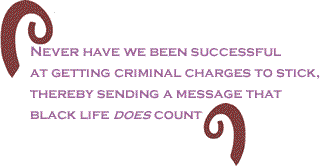 In
In
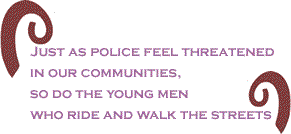 In
the Sean Bell case, Judge Arthur Cooperman referred to the actions
of the NY undercover cops as careless and incompetent, yet still
acquitted the trigger-happy trio. Newly appointed NY Governor
David Paterson claimed he was “surprised” about the verdict,
given the number of rounds fired, but stated the justice system
had worked. It reminded me of
In
the Sean Bell case, Judge Arthur Cooperman referred to the actions
of the NY undercover cops as careless and incompetent, yet still
acquitted the trigger-happy trio. Newly appointed NY Governor
David Paterson claimed he was “surprised” about the verdict,
given the number of rounds fired, but stated the justice system
had worked. It reminded me of 

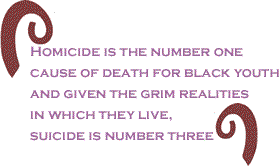 Hanging
out not only makes young people a target for profiling by police
but also targets of other teens. Homicide is the number one
cause of death for black youth and given the grim realities
in which they live, suicide is number three. Our communities
and the few support systems left must rise to the occasion.
The Bush administration has put us all in peril but our children
and youth are the most vulnerable.
Hanging
out not only makes young people a target for profiling by police
but also targets of other teens. Homicide is the number one
cause of death for black youth and given the grim realities
in which they live, suicide is number three. Our communities
and the few support systems left must rise to the occasion.
The Bush administration has put us all in peril but our children
and youth are the most vulnerable.